Study on Spatial Distribution and Heritage Corridor Network of Traditional Settlements in Ancient Huizhou
Abstract
1. Introduction
2. Literature Review
2.1. Heritage Corridor Theory
2.2. Research Content and Practical Cases of Heritage Corridors
2.3. Limitations of Heritage Corridor Research and New Ideas for Traditional Settlement Protection
3. Materials and Methods
3.1. Study Area
3.2. Data Sources
3.3. Research Framework
3.4. Research Methodology
- 1.
- Type of Spatial Distribution: Nearest Neighbor Index
- 2.
- Spatial Distribution Density Characteristics: Kernel Density Analysis
- 3.
- Spatial Distribution Orientation Characteristics: Standard Deviation Ellipse Analysis
- 4.
- Weight Allocation of Resistance Factors: AHP
- 5.
- Construction of Heritage Corridors: Circuit Theory
- 6.
- sDNA
4. Results
4.1. Characteristics of Spatial Distribution of Heritage
4.1.1. Type of Spatial Distribution
4.1.2. Spatial Distribution Density Characteristics
4.1.3. Spatial Distribution Orientation Characteristics
4.2. Construction of Heritage Corridor Network
4.2.1. Selection of Resistance Factors
4.2.2. Construction of Integrated Resistance Surfaces
4.2.3. Construction of Heritage Corridors
4.2.4. Analysis of Heritage Corridor Network
5. Discussion
5.1. Constructing a “Three-Core-Driven, Two-Axis Linkage, Multi-Source Synergy” Protection Mechanism
5.1.1. Constructing a “Three-Core Synergy, Corridor Symbiosis” Protection System
- The water network takes the water vein cultural core of She County as the hub, relies on the Xin’an River water corridor, and connects the riverside settlements such as Xu Village and Changxi Village through the core node of Huizhou Ancient City, forming a “water vein weaving network” style spatial sequence, strengthening the historical connection between water and land, and restoring the water culture interaction between settlements.
- Heritage radiation takes Yi County double legacy artisan nucleus as the center, relying on Xidi Village and Hong Village world cultural heritage sites, constructs a radial network with a radius of 15 km, linking Namping village, Guanlu Village and other Ming and Qing dynasty trade settlement clusters, forming a core-driven cultural dissemination system with the synergistic development of the peripheral settlements, and further expanding the cultural influence of the traditional settlements.
- The ecological transition level relies on the Xiuwu County Marginal exchange nucleus, based on the ecological barrier of Wulong Mountain Range, and through the linkage of terrace ecosystem of Huangling Village and high mountains of Mulihong Village, to construct the cultural transition belt of Anhui and Jiangxi, forming a spatial pattern of ecological protection and cultural integration in parallel.
5.1.2. Strengthening the “Twin-Axis” Protection System
5.1.3. Identify Transport Hub Nodes
5.2. Heritage Corridor Protection Strategy Based on sDNA
- 1.
- Regional Level: Cross-Provincial Resource Integration
- 2.
- County Level: Corridor Restoration and Node Linkage
6. Conclusions
Author Contributions
Funding
Data Availability Statement
Conflicts of Interest
Abbreviations
| UNESCO | United Nations Educational, Scientific and Cultural Organization |
| HUL | Historic Urban Landscape |
| AHP | Analytic Hierarchy Process |
| MCR | Minimum Cumulative Resistance |
| GIS | Geographic Information System |
| CCSPM | Cultural Corridor Spatial Planning Model |
| NHA | National Heritage Areas |
| DEM | Digital Elevation Model |
| OSM | OpenStreetMap |
| ANN | Average Nearest Neighbor |
| sDNA | spatial Design Network Analysis |
| CWD/PL | Cumulative Resistance Distance/Path Length Ratio |
| NQPDA | Network Quantity Penalized by Distance Angular |
References
- Tao, J.; Li, G.; Xiao, D.; Zhuo, X. Evolution and Prospects of Traditional Rural Settlements in China. South Archit. 2024, 1–24. (In Chinese) [Google Scholar] [CrossRef]
- Liu, P.; Zeng, C.; Liu, R. Environmental Adaptation of Traditional Chinese Settlement Patterns and Its Landscape Gene Mapping. Habitat Int. 2023, 135, 102808. [Google Scholar] [CrossRef]
- Izakovičová, Z.; Petrovič, F.; Pauditšová, E. The Impacts of Urbanisation on Landscape and Environment: The Case of Slovakia. Sustainability 2022, 14, 60. [Google Scholar] [CrossRef]
- Lu, S.; Rao, X.; Duan, P. Rural Gentrification and Its Impacts in Traditional Villages—A Case Study of Xixinan Village, China. Sustainability 2022, 14, 10077. [Google Scholar] [CrossRef]
- Li, J.; Wang, J.; Li, X. Heritage Value Assessment and Landscape Preservation of Traditional Chinese Villages Based on the Daily Lives of Local Residents: A Study of Tangfang Village in China and the UNESCO HUL Approach. Land 2024, 13, 1535. [Google Scholar] [CrossRef]
- Ma, K. Research of Spatial Network Elements and Its Structure Characteristics in Ancient Huizhou Traditional Settlements. Master’s Thesis, Anhui Jianzhu University, Hefei, China, 2018. (In Chinese). [Google Scholar]
- Bhati, H.V.; Epstein, Y. Protection of Biocultural Heritage in the Anthropocene: Towards Reconciling Natural, Cultural, Tangible and Intangible Heritage. J. Environ. Law 2023, 35, 353–375. [Google Scholar] [CrossRef]
- Liu, X.; Yuan, L.; Tan, G. Identification and Hierarchy of Traditional Village Characteristics Based on Concentrated Contiguous Development—Taking 206 Traditional Villages in Hubei Province as an Example. Land 2023, 12, 471. [Google Scholar] [CrossRef]
- Wang, D.; Zhu, Y.; Zhao, M.; Lv, Q. Multi-Dimensional Hollowing Characteristics of Traditional Villages and Its Influence Mechanism Based on the Micro-Scale: A Case Study of Dongcun Village in Suzhou, China. Land Use Policy 2021, 101, 105146. [Google Scholar] [CrossRef]
- Zhang, L.; Sun, J.; Deng, L.; Luo, J.; Tian, Y. Characteristics of multi-scale spatiotemporal pattern and influencing factors of Chinese traditional villages. Res. Soil Water Conserv. 2025, 32, 321–330. (In Chinese) [Google Scholar] [CrossRef]
- Li, G.; Hu, W. A Network-Based Approach for Landscape Integration of Traditional Settlements: A Case Study in the Wuling Mountain Area, Southwestern China. Land Use Policy 2019, 83, 105–112. [Google Scholar] [CrossRef]
- He, D.; Chen, W.; Zhang, J. Integrating Heritage and Environment: Characterization of Cultural Landscape in Beijing Great Wall Heritage Area. Land 2024, 13, 536. [Google Scholar] [CrossRef]
- Pendlebury, J. The Conservation of Historic Areas in the UK. Cities 1999, 16, 423–433. [Google Scholar] [CrossRef]
- Sebti, M.; Alkama, D.; Bouchair, A. Assessment of the Effect of Modern Transformation on the Traditional Settlement ‘Ksar’ of Ouargla in Southern Algeria. Front. Archit. Res. 2013, 2, 322–337. [Google Scholar] [CrossRef]
- Liu, X.; Li, Y.; Wu, Y.; Li, C. The Spatial Pedigree in Traditional Villages under the Perspective of Urban Regeneration-Taking 728 Villages in Jiangnan Region, China as Cases. Land 2022, 11, 1561. [Google Scholar] [CrossRef]
- Zhong, Q.; Dong, T. Exploring the Spatiotemporal Trends and Influencing Factors of Human Settlement Suitability in Hunan Province Traditional Villages. Sci. Rep. 2024, 14, 25319. [Google Scholar] [CrossRef]
- Feng, Y.; Wei, H.; Huang, Y.; Li, J.; Mu, Z.; Kong, D. Spatiotemporal Evolution Characteristics and Influencing Factors of Traditional Villages: The Yellow River Basin in Henan Province, China. Herit. Sci. 2023, 11, 97. [Google Scholar] [CrossRef]
- Laven, D.; Ventriss, C.; Manning, R.; Mitchell, N.; Evaluating, U.S. National Heritage Areas: Theory, Methods, and Application. J. Environ. Manag. 2010, 46, 195–212. [Google Scholar] [CrossRef]
- Zingraff-Hamed, A.; Bonnefond, M.; Bonthoux, S.; Legay, N.; Greulich, S.; Robert, A.; Rotgé, V.; Serrano, J.; Cao, Y.; Bala, R.; et al. Human–River Encounter Sites: Looking for Harmony between Humans and Nature in Cities. Sustainability 2021, 13, 2864. [Google Scholar] [CrossRef]
- Hu, X.; Li, H.; Zhang, X.; Chen, X.; Yuan, Y. Multi-Dimensionality and the Totality of Rural Spatial Restructuring from the Perspective of the Rural Space System: A Case Study of Traditional Villages in the Ancient Huizhou Region, China. Habitat Int. 2019, 94, 102062. [Google Scholar] [CrossRef]
- Fang, Q.; Li, Z. Cultural Ecology Cognition and Heritage Value of Huizhou Traditional Villages. Heliyon 2022, 8, e12627. [Google Scholar] [CrossRef]
- Wang, X.; Lai, J.; Guo, Y. Study on Tourism Responsiveness and Habitat Environment-Influencing Factors of Traditional Villages in Huizhou Area. Sustainability 2024, 16, 3424. [Google Scholar] [CrossRef]
- Wang, W.; Liu, A.; Xu, X. The Spatio-Temporal Evolution and Sustainable Development Strategy of Huizhou’s Traditional Villages in the Xin’an River Basin. Land 2025, 14, 102. [Google Scholar] [CrossRef]
- Chen, X.; Xie, W.; Li, H. The Spatial Evolution Process, Characteristics and Driving Factors of Traditional Villages from the Perspective of the Cultural Ecosystem: A Case Study of Chengkan Village. Habitat Int. 2020, 104, 102250. [Google Scholar] [CrossRef]
- Ding, J.; Gao, Z.; Ma, S. Understanding Social Spaces in Tourist Villages through Space Syntax Analysis: Cases of Villages in Huizhou, China. Sustainability 2022, 14, 12376. [Google Scholar] [CrossRef]
- Bian, M.; Huang, Z.; Chen, Q.; Liu, G.; Zhang, Y.; Ding, S. Optimization of Plane and Space of New Dwellings in Southern Anhui Province Based on Indoor Thermal Environment. Sustainability 2022, 14, 5694. [Google Scholar] [CrossRef]
- Yue, F.; Li, X.; Huang, Q.; Li, D. A Framework for the Construction of a Heritage Corridor System: A Case Study of the Shu Road in China. Remote Sens. 2023, 15, 4650. [Google Scholar] [CrossRef]
- Du, C.; Pan, D.; Liu, Q. The Construction of a Protection Network for Traditional Settlements across Regions: A Case Study of the Chengdu–Chongqing Ancient Post Road Heritage Corridor in China. Land 2025, 14, 327. [Google Scholar] [CrossRef]
- Fan, X.; Wang, Z.; Li, S. Value Evaluation Model (VEM) of Ancient Chinese Military Settlement Heritage: A Case Study of Liaoxi Corridor in the Ming Dynasty. Herit. Sci. 2024, 12, 97. [Google Scholar] [CrossRef]
- Wang, Q.; Yang, C.; Wang, J.; Tan, L. Tourism in Historic Urban Areas: Construction of Cultural Heritage Corridor Based on Minimum Cumulative Resistance and Gravity Model—A Case Study of Tianjin, China. Buildings 2024, 14, 2144. [Google Scholar] [CrossRef]
- Lin, F.; Zhang, X.; Ma, Z.; Zhang, Y. Spatial Structure and Corridor Construction of Intangible Cultural Heritage: A Case Study of the Ming Great Wall. Land 2022, 11, 1478. [Google Scholar] [CrossRef]
- Li, X.; Zhu, R.; Shi, C.; Yang, X.; Chen, J.; Wei, K. Research on the Construction of Intangible Cultural Heritage Corridors in the Yellow River Basin Based on Geographic Information System (GIS) Technology and the Minimum Cumulative Resistance (MCR) Model. Herit. Sci. 2024, 12, 271. [Google Scholar] [CrossRef]
- Ye, H.; Yang, Z.; Xu, X. Ecological Corridors Analysis Based on MSPA and MCR Model—A Case Study of the Tomur World Natural Heritage Region. Sustainability 2020, 12, 959. [Google Scholar] [CrossRef]
- Zhang, Q.; Ge, J. Research on the Construction of Huizhou Heritage Corridor Network from the Perspective of Cultural Ecology. Ind. Constr. 2024, 54, 20–29. [Google Scholar] [CrossRef]
- Sun, Y.; Wang, Y.; Liu, L.; Wei, Z.; Li, J.; Cheng, X. Large-Scale Cultural Heritage Conservation and Utilization Based on Cultural Ecology Corridors: A Case Study of the Dongjiang-Hanjiang River Basin in Guangdong, China. Herit. Sci. 2024, 12, 44. [Google Scholar] [CrossRef]
- Tao, L.; Wang, H.; Li, J.; Zhang, L. Construction of CCSPM model for spatial definition of cultural corridor. A case study of cross-border cultural corridor in Southwest Yunnan. Geogr. Sci. 2022, 42, 602–610. (In Chinese) [Google Scholar] [CrossRef]
- Yu, K.; Xi, X.; Li, D.; Li, H.; Liu, K. On the Construction of the National Linear Culture Heritage Network in China. Hum. Geogr. 2009, 24, 11–16, 116. (In Chinese) [Google Scholar] [CrossRef]
- Yuan, Y.; Xu, J.; Zhang, X. Construction of Heritage Corridor Network Based on Suitability Analysis: A Case Study of the Ancient Capital of Luoyang. Remote Sens. Inf. 2014, 29, 117–124. (In Chinese) [Google Scholar] [CrossRef]
- Zhang, S.; Yu, W. Canal Heritage Tourism Utilization Models: Experience and Inspirations from the Grand Canal (Beijing Section). Land 2024, 13, 860. [Google Scholar] [CrossRef]
- Wu, Y.; Miao, M.; Wu, Y.; Zhu, H.; Li, X.; Candeias, A. The Research on the Construction of Traditional Village Heritage Corridors in the Taihu Lake Region Based on the Current Effective Conductance (CEC) Theory. Buildings 2025, 15, 472. [Google Scholar] [CrossRef]
- Ministry of Culture and Tourism of the People’s Republic of China. Available online: https://www.mct.gov.cn (accessed on 5 March 2025).
- China Traditional Villages Network. Available online: http://www.chuantongcunluo.com (accessed on 5 March 2025).
- Resource and Environment Science Data Center, Chinese Academy of Sciences. Available online: http://www.resdc.cn (accessed on 23 February 2025).
- Baidu Coordinate Pickup System. Available online: https://api.map.baidu.com/lbsapi/getpoint/index.html (accessed on 10 March 2025).
- Geospatial Data Cloud. Available online: http://www.gscloud.cn (accessed on 23 February 2025).
- National Basic Geographic Information Center. Available online: http://www.ngcc.cn (accessed on 23 February 2025).
- OpenStreetMap. Available online: http://www.openstreetmap.org (accessed on 24 February 2025).
- Wang, Y.; Li, Y.; Zhai, B.; Feng, X. Heritage Network Theory and ltsImplications for the Conservation Renewal of Historic Cities. Urban Archit. 2024, 21, 38–43. (In Chinese) [Google Scholar] [CrossRef]
- Tian, Y.; Chen, P.; Lu, P.; Yang, H.; Yang, S.; Zhang, L.; Wei, Q.; Zhao, X.; Guo, L.; Wang, Z.; et al. Evolution of Influence Ranges of Neolithic-Bronze Age Cities in the Songshan Mountain Region of Central China Based on GIS Spatial Analysis. Remote Sens. 2022, 14, 5631. [Google Scholar] [CrossRef]
- Zhang, Y.; Li, J.; Wang, J.; Xin, A. Spatial Correlation between Traditional Villages and Religious Cultural Heritage in the Hehuang Region, Northwest China. J. Asian Archit. Build. Eng. 2024, 1–13. [Google Scholar] [CrossRef]
- Ning, Z.Z.; Wang, T.; Yang, X.C. Spatio-Temporal Evolution of Tourist Attractions and Formation of Attraction Clusters in China since 2001. Geogr. Res. 2020, 39, 1654–1666. [Google Scholar]
- Esbah, H.; Cook, E.A.; Ewan, J. Effects of Increasing Urbanization on the Ecological Integrity of Open Space Preserves. Environ. Manag. 2009, 43, 846–862. [Google Scholar] [CrossRef]
- Zhang, L.; Tian, F.; Zheng, X.; Sun, Z. Spatial Configuration of Fire Protection for Historical Streets in China Using Space Syntax. J. Cult. Herit. 2023, 59, 140–150. [Google Scholar] [CrossRef]
- Li, J.; Chu, J.; Ye, J.; Liu, H.; Zhang, J. Spatial Evolutionary Characteristics and Driving Mechanism of Traditional Villages in Ancient Huizhou. Econ. Geogr. 2018, 38, 153–165. (In Chinese) [Google Scholar] [CrossRef]
- Lu, S.; Zhang, X. Temporal-Spatial Distribution Characteristics and Impact Factors of Traditional Villages in Huizhou Area. Econ. Geogr. 2019, 39, 204–211. (In Chinese) [Google Scholar] [CrossRef]
- Lu, L.; Ling, S.; Jiao, H.; Yang, X. Study on evolution process and mechanism of Huizhou ancient village. Geogr. Res. 2004, 5, 686–694. (In Chinese) [Google Scholar] [CrossRef]
- Shao, Y.; Chen, H.; Hu, L. The System,Types and Characteristics of Historic Settlements in Southern Anhui. Herit. Archit. 2021, 1, 38–51. (In Chinese) [Google Scholar] [CrossRef]
- Yang, J.; Ren, K. Analysis of the Types and Characteristics of Huizhou’s Characteristic Villages and Towns. J. Hum. Settl. West. China 2023, 38, 1–8. (In Chinese) [Google Scholar] [CrossRef]
- Ding, Q.; Yang, Z.; Huang, Z. Spatial and Temporal Distribution Characteristics and Geographic Contexts of Civilized Villages in China. PLoS ONE 2024, 19, e0305591. [Google Scholar] [CrossRef] [PubMed]
- Fang, Y.; Lu, H.; Huang, Z.; Zhu, Z. Spatiotemporal Distribution of Chinese Traditional Villages and Its Influencing Factors. Econ. Geogr. 2023, 43, 187–196. (In Chinese) [Google Scholar] [CrossRef]
- Yang, Q.; Zhang, F.; An, Y.; Sun, C.; Wu, J.; Zhang, Y.; Wei, Z. Research on the Spatial Distribution Pattern and Influencing Factors of China’s Antipoverty (pro-Poor Tourism) on GIS. Discret. Dyn. Nat. Soc. 2021, 2021, 6682498. [Google Scholar] [CrossRef]
- Zhang, H.; Wang, Y.; Qi, Y.; Chen, S.; Zhang, Z. Assessment of Yellow River Region Cultural Heritage Value and Corridor Construction across Urban Scales: A Case Study in Shaanxi, China. Sustainability 2024, 16, 1004. [Google Scholar] [CrossRef]
- Wang, Y.; Chen, X. The Construction of Red Cultural Heritage Corridor in Jinggang Mountain Based on MCR Model. Huazhong Archit. 2024, 42, 51–55. (In Chinese) [Google Scholar] [CrossRef]
- Huang, H.; Zhang, M.; Yu, K.; Gao, Y.; Liu, J. Construction of Complex Network of Green Infrastructure in Smart City under Spatial Differentiation of Landscape. Comput. Commun. 2020, 154, 380–389. [Google Scholar] [CrossRef]
- Zhao, Y.; Cao, J.; Zhang, X.; Zhang, M. Analyzing the Characteristics of Land Use Distribution in Typical Village Transects at Chinese Loess Plateau Based on Topographical Factors. Open Geosci. 2022, 14, 429–442. [Google Scholar] [CrossRef]
- Wang, F.; Gao, C. Settlement-River Relationship and Locality of River-Related Built Environment. Indoor Built Environ. 2020, 29, 1331–1335. [Google Scholar] [CrossRef]
- Chu, J.L.; Li, Y.; Li, J.L. Present Characteristics and Protection Path of Linear Cultural Heritage Based on “Patch-Corridor-Matrix”: A Case of Huizhou Ancient Road. Small Town Constr. 2019, 37, 46–52, 60. (In Chinese) [Google Scholar] [CrossRef]



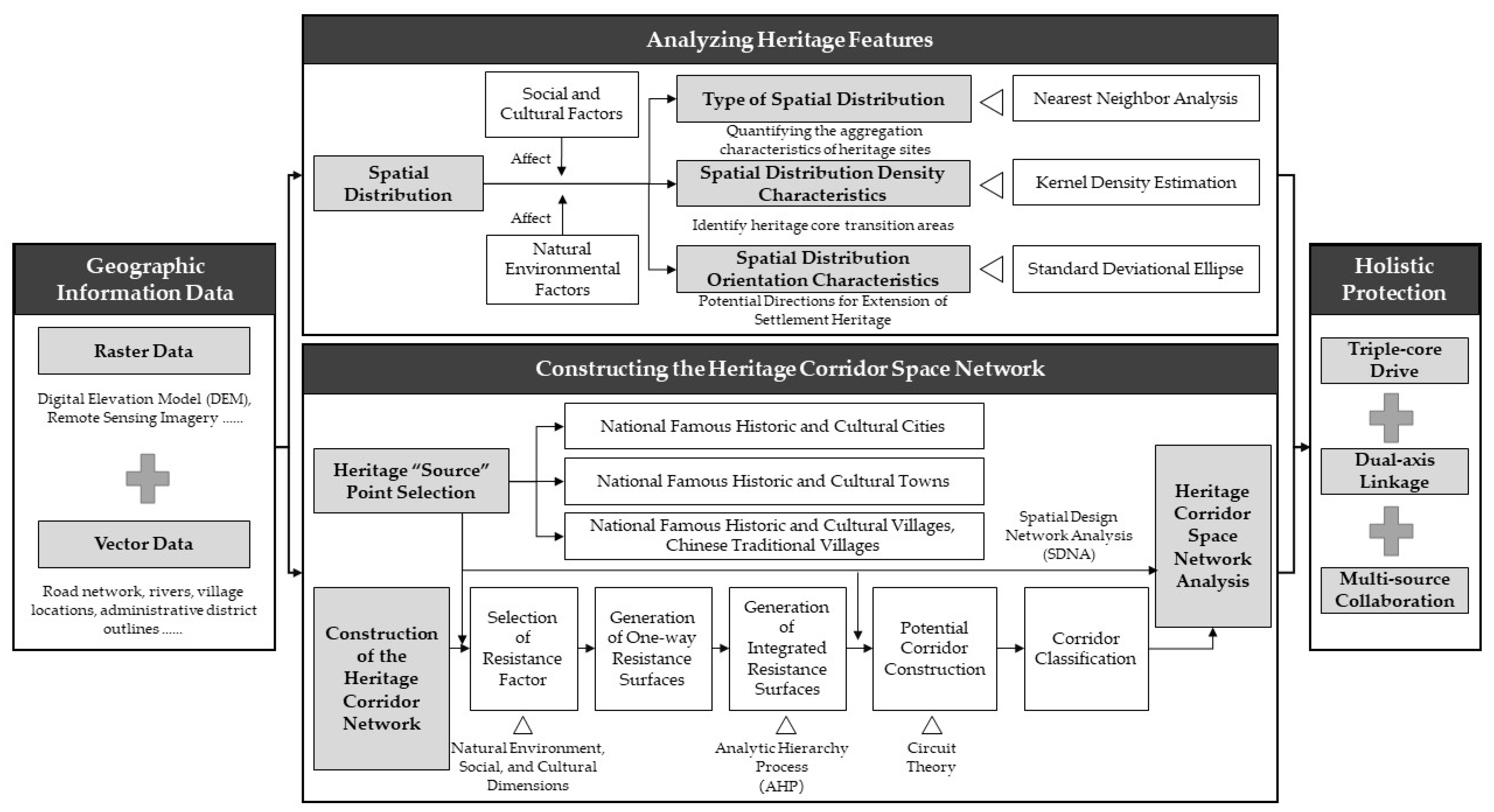
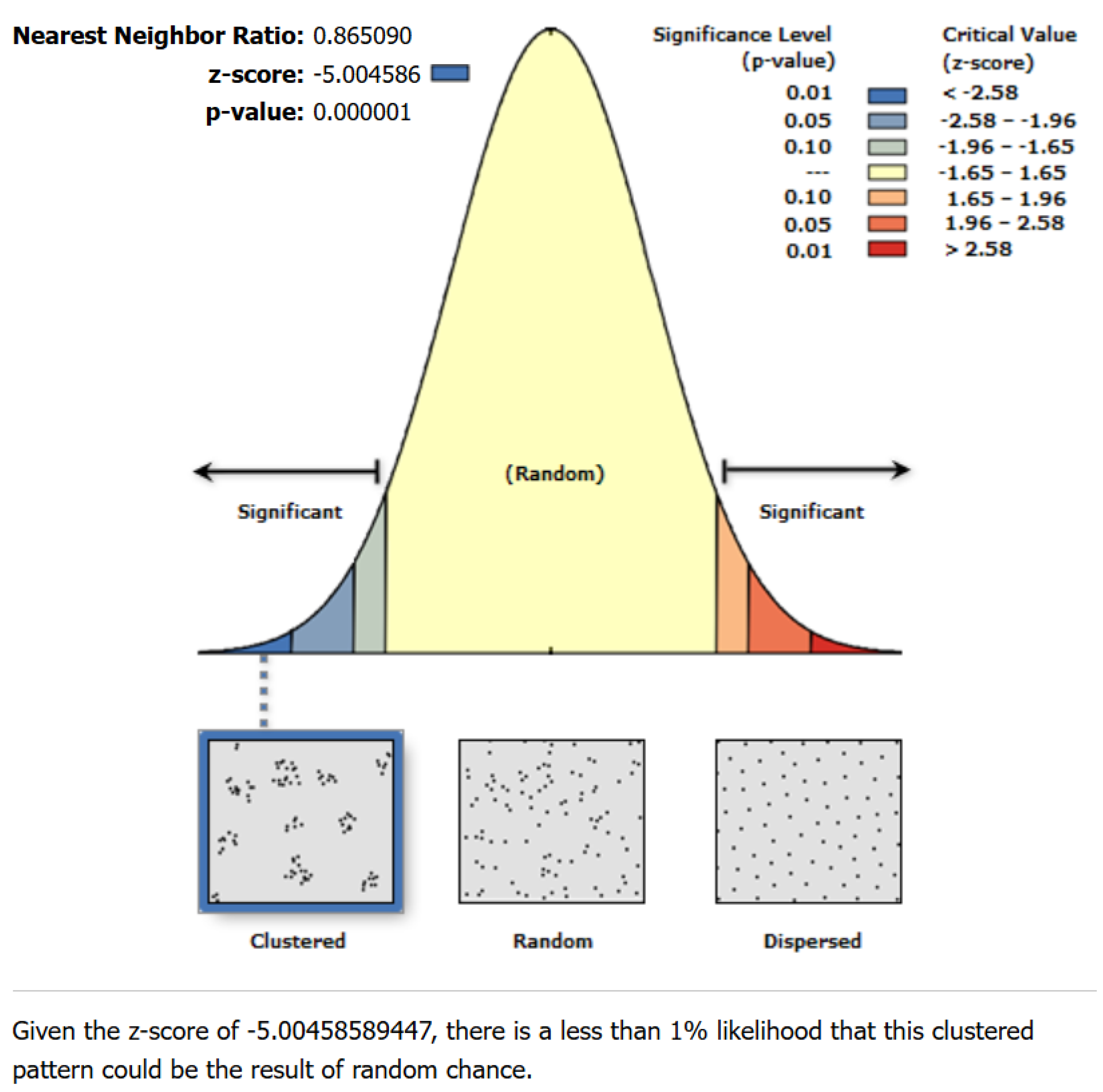

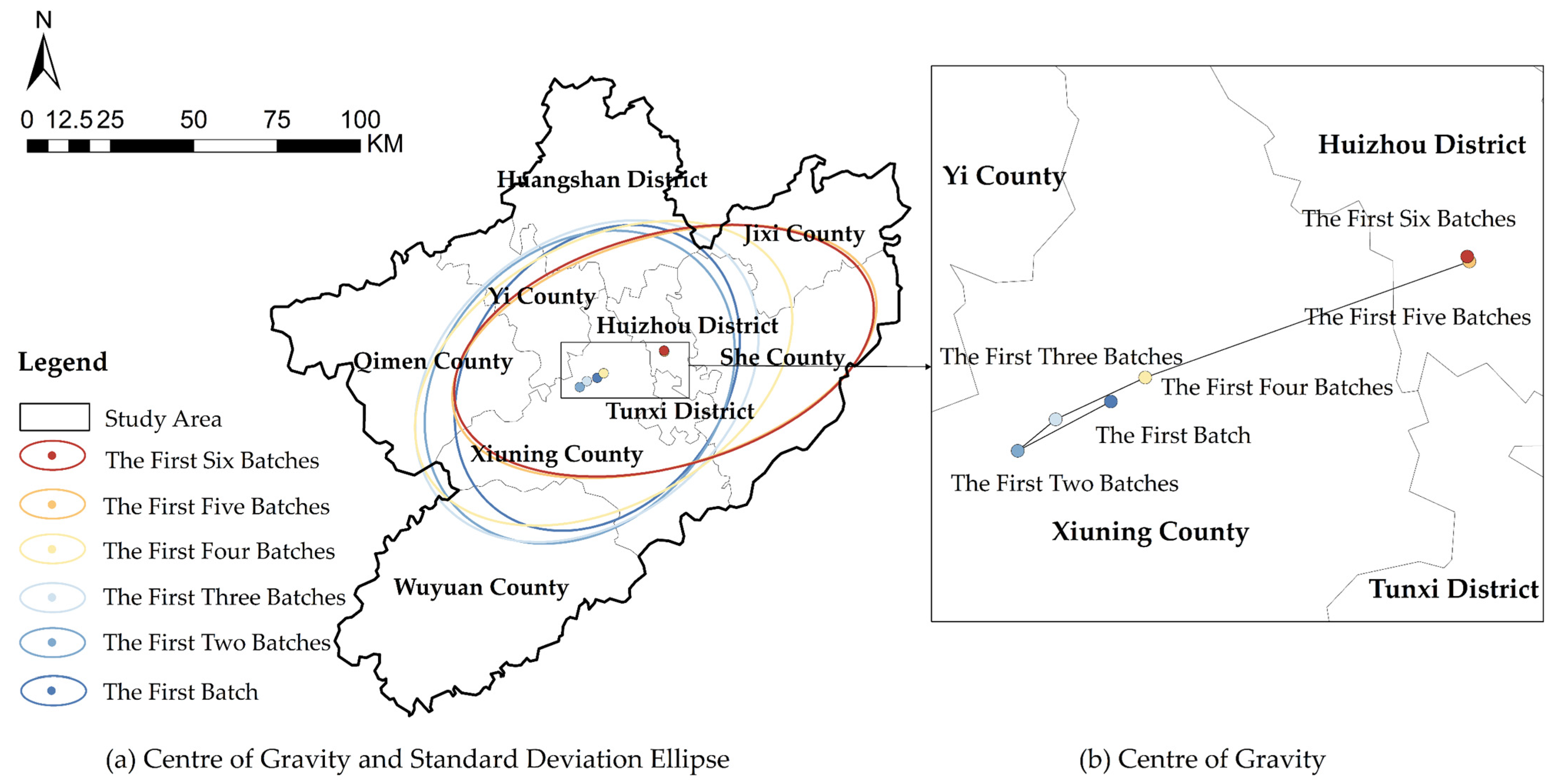

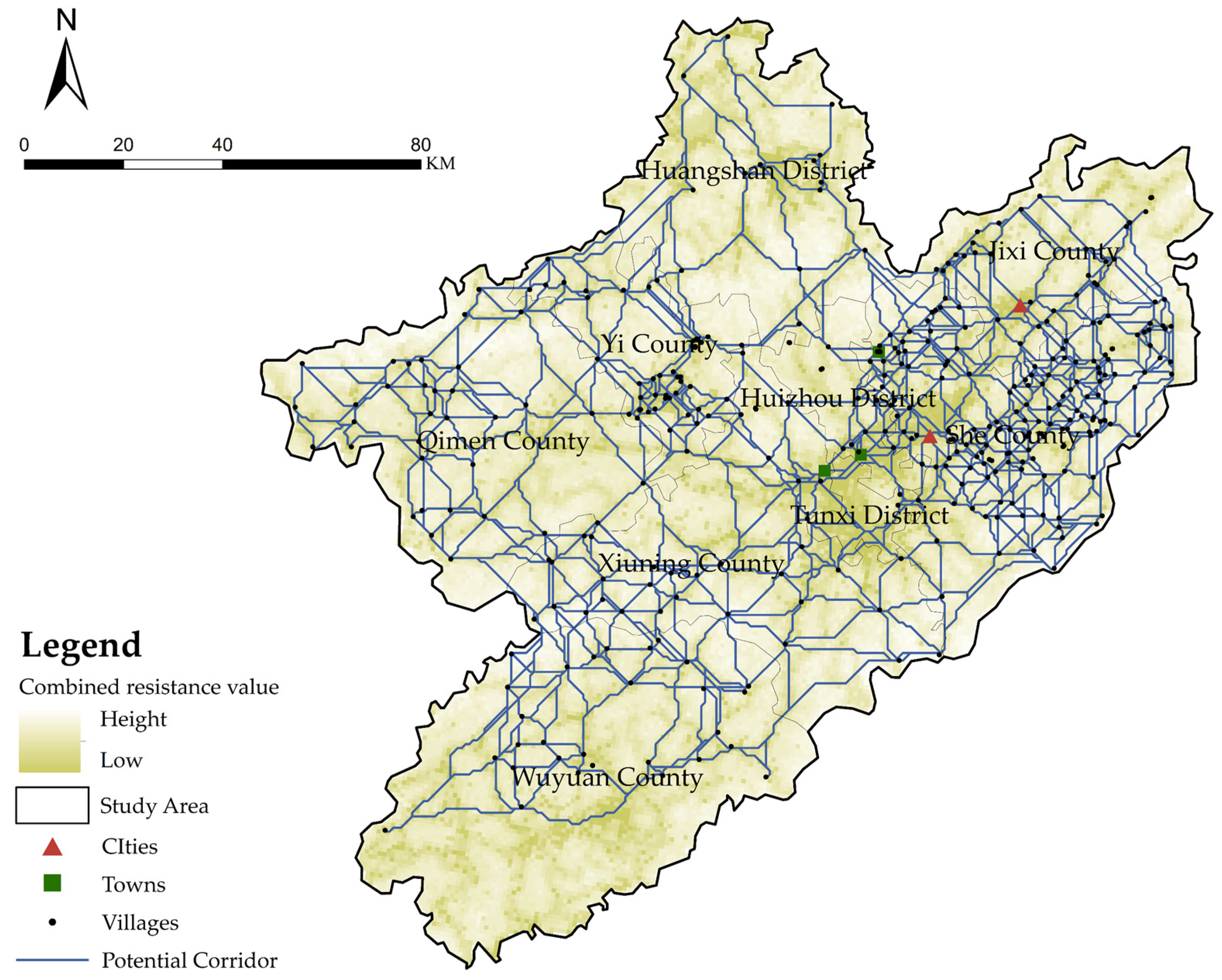
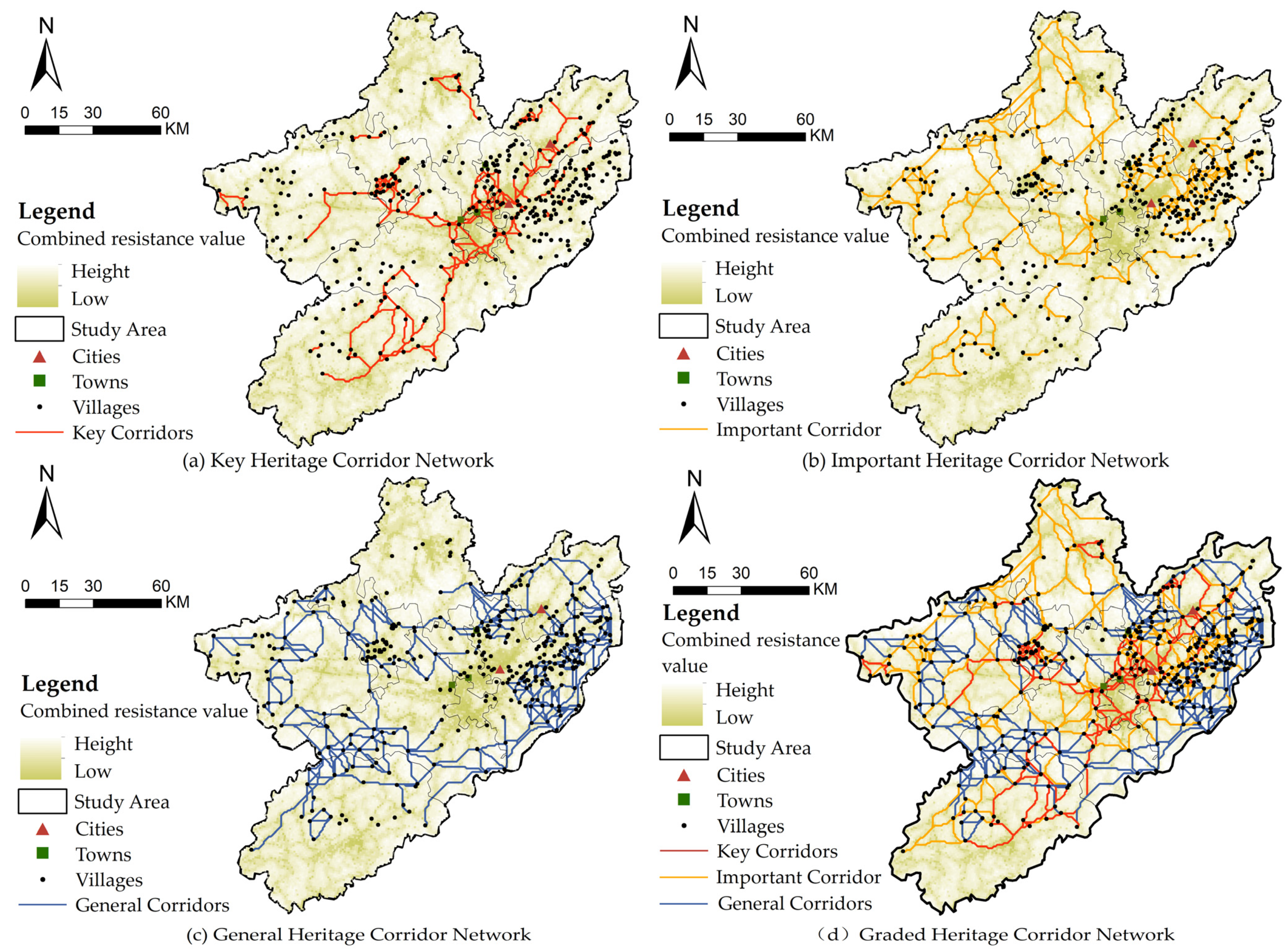




| Provinces | City | County | Area (km2) | Villages (Number) | Towns (Number) | Cities (Number) | Total | Proportion (%) |
|---|---|---|---|---|---|---|---|---|
| Anhui Province | Huangshan City | She County | 2827.21 | 167 | 1 | 1 | 169 | 0.449 |
| Yi County | 1140.42 | 46 | 0 | 0 | 46 | 0.122 | ||
| Xiuning County | 2805.85 | 37 | 1 | 0 | 38 | 0.101 | ||
| Qimen County | 2948.24 | 33 | 0 | 0 | 33 | 0.088 | ||
| Huangshan District | 2337.54 | 13 | 0 | 0 | 13 | 0.035 | ||
| Huizhou District | 556.18 | 12 | 1 | 0 | 13 | 0.035 | ||
| Tunxi District | 255.24 | 2 | 0 | 0 | 2 | 0.005 | ||
| Xuancheng City | Jixi County | 1474.5 | 31 | 0 | 1 | 32 | 0.085 | |
| Jiangxi Province | Shangrao City | Wuyuan County | 3894.30 | 30 | 0 | 0 | 30 | 0.080 |
| Data Type | Data Source |
|---|---|
| Traditional Settlement Data | Ministry of Culture and Tourism of the People’s Republic of China [41], China Traditional Villages Network [42] |
| Administrative Boundaries | Resource and Environmental Science Data Center of the Chinese Academy of Sciences [43] |
| Traditional Settlement Coordinate Points | Baidu Coordinate Pickup System [44] |
| DEM Elevation Data | Geospatial Data Cloud Platform [45] |
| Land Use Type, Settlement Data | National Basic Geographic Information Center [46] |
| Road Traffic, Water System Data | OpenStreetMap Platform [47] |
| Province | City | County | Observed Mean Distance (m) | Expected Mean Distance (m) | Nearest Neighbor Ratio | z Score | p Value | Distribution Type |
|---|---|---|---|---|---|---|---|---|
| Anhui Province | Xuancheng City | Jixi County | 2391.555 | 3448.354 | 0.694 | −3.264 | 0.001 | Clustered |
| Huangshan City | Qimen County | 5905.985 | 4726.007 | 1.250 | 2.744 | 0.006 | Dispersed | |
| Xiuning County | 5042.988 | 4354.133 | 1.158 | 1.841 | 0.066 | Dispersed | ||
| Huangshan District | 8502.056 | 6704.677 | 1.268 | 1.849 | 0.064 | Dispersed | ||
| Yi County | 2199.121 | 2489.567 | 0.883 | −1.514 | 0.13 | Random | ||
| She County | 1949.585 | 2051.137 | 0.950 | −1.228 | 0.22 | Random | ||
| Huizhou District | 3859.683 | 3270.449 | 1.18 | 1.243 | 0.214 | Random | ||
| Tunxi District | 2214.397 | 5648.472 | 0.392 | −1.645 | 0.1 | Random | ||
| Jiangxi Province | Shangrao City | Wuyuan County | 5125.383 | 5696.710 | 0.900 | −1.051 | 0.293 | Random |
| Batch | Center X (°) | Center Y (°) | X Std Dist (km) | Y Std Dist (km) | Rotation (°) | Circumference (km) | Area (km2) | Oblateness |
|---|---|---|---|---|---|---|---|---|
| First batch | 118.077277 | 29.815805 | 49.736 | 38.250 | 37.092 | 277.591 | 5976.247 | 0.231 |
| First 2 batches | 118.030229 | 29.794034 | 51.791 | 41.115 | 43.801 | 292.832 | 6689.302 | 0.206 |
| First 3 batches | 118.049358 | 29.807867 | 56.748 | 42.072 | 51.433 | 312.161 | 7500.113 | 0.259 |
| First 4 batches | 118.094585 | 29.826376 | 61.065 | 39.563 | 60.497 | 319.744 | 7589.276 | 0.352 |
| First 5 batches | 118.258464 | 29.87764 | 65.661 | 34.37 | 73.266 | 321.981 | 7089.165 | 0.477 |
| First 6 batches | 118.257417 | 29.879835 | 64.662 | 34.846 | 74.390 | 319.664 | 7078.213 | 0.461 |
| Serial Number | Resistance Factor |
|---|---|
| 1 | Land Use Type, Elevation, Slope [32] |
| 2 | Land Use Type, Elevation, Slope, Distance from Major Roads [62] |
| 3 | Land Use Type, Elevation, Slope, Distance from Major Roads, Distance from Rivers [31] |
| 4 | Land Use Type, Elevation, Slope, Distance from Major Roads, Distance from Rivers [35] |
| 5 | Land Use Type, Elevation, Slope, Distance from Major Roads, Distance from Rivers [33] |
| 6 | Land Use Type, Elevation, Slope, Distance from Major Roads, Distance from Rivers, Distance from Residential Area [63] |
| 7 | Land Use Type, Elevation, Slope, NDVI, Distance from Major Roads, Distance from Rivers [64] |
| 8 | Land Use Type, Elevation, Slope, Distance from Major Roads, Distance from Rivers, Distance from Restaurants, Distance from Scenic Spots, Distance from Hotels [27] |
| 9 | Land Use Type, Elevation, Slope, Slope aspect, Distance from Major Roads, Distance from Rivers, Vegetation Cover, Distance from Public Transportation Stations, Distance from Public Service Facilities [30] |
| 10 | Land Use Type, Elevation, Slope, Distance from Major Roads, Vegetation Cover, Water Body Buffer Analysis, Terrain Relief, Night Light Index, Distance from Restaurants, Distance from Hotels, Distance from Scenic Spots [34] |
| Type | Resistance Factor | Weight | Resistance Value | ||||
|---|---|---|---|---|---|---|---|
| 1 | 2 | 3 | 4 | 5 | |||
| Natural Environment | Elevation (m) | 0.106 | <200 | 200–400 | 400–600 | 600–800 | >800 |
| Slope (°) | 0.145 | <5 | 5–10 | 10–25 | 25–40 | >40 | |
| Types of Land Use | 0.280 | Construction land, unused land | Cultivated land | Grassland | River system | Forest land | |
| Distance from Rivers | 0.095 | <0.5 | 0.5–1 | 1–2.5 | 2.5–5 | >5 | |
| Society and Culture | Night Light Index | 0.053 | >12 | 6–12 | 2.5–6 | 0.5–2.5 | <0.5 |
| Distance from Residential Area | 0.148 | <2 | 2–5 | 5–10 | 10–15 | >15 | |
| Distance from Major Roads | 0.173 | <200 | 200–500 | 500–1000 | 1000–1500 | >1500 | |
Disclaimer/Publisher’s Note: The statements, opinions and data contained in all publications are solely those of the individual author(s) and contributor(s) and not of MDPI and/or the editor(s). MDPI and/or the editor(s) disclaim responsibility for any injury to people or property resulting from any ideas, methods, instructions or products referred to in the content. |
© 2025 by the authors. Licensee MDPI, Basel, Switzerland. This article is an open access article distributed under the terms and conditions of the Creative Commons Attribution (CC BY) license (https://creativecommons.org/licenses/by/4.0/).
Share and Cite
Wu, Y.; Yang, Y.; Miao, M.; Wu, Y.; Zhu, H. Study on Spatial Distribution and Heritage Corridor Network of Traditional Settlements in Ancient Huizhou. Buildings 2025, 15, 1641. https://doi.org/10.3390/buildings15101641
Wu Y, Yang Y, Miao M, Wu Y, Zhu H. Study on Spatial Distribution and Heritage Corridor Network of Traditional Settlements in Ancient Huizhou. Buildings. 2025; 15(10):1641. https://doi.org/10.3390/buildings15101641
Chicago/Turabian StyleWu, Yao, Yuxin Yang, Mingrui Miao, Yonglan Wu, and Hui Zhu. 2025. "Study on Spatial Distribution and Heritage Corridor Network of Traditional Settlements in Ancient Huizhou" Buildings 15, no. 10: 1641. https://doi.org/10.3390/buildings15101641
APA StyleWu, Y., Yang, Y., Miao, M., Wu, Y., & Zhu, H. (2025). Study on Spatial Distribution and Heritage Corridor Network of Traditional Settlements in Ancient Huizhou. Buildings, 15(10), 1641. https://doi.org/10.3390/buildings15101641










